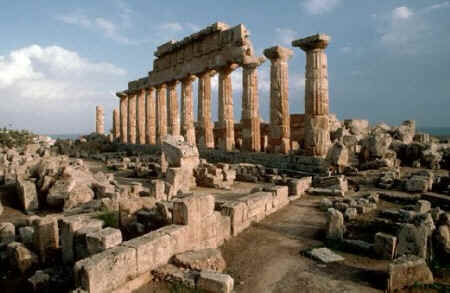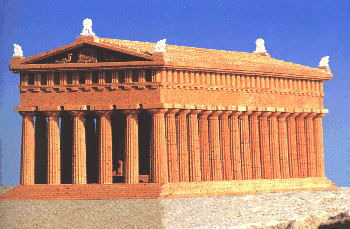 The main
tempie of the acropolis built around the middle of the VI century B.C. is a monumental peripteros The main
tempie of the acropolis built around the middle of the VI century B.C. is a monumental peripteros(measurements of the upper step/stylobate: 23.63 x 63.77 m) of 6/17 colunins. With its double colonnade of the facade and with its great, access straircase, the temple is elearly orientated towards the East, towards the area of worship.The spacious peristasis enclose the cella whose elongated shape recalls the ancient megaron.fhe pronaos opens in a great portal, ,whose two main wings could be manoeuvred in three elements each, this being evidenced by signs of circular rails preserved on the threshold. In the middle of the main room, in the naos, there was a table for sacrifices and votive offerings, while the cult image was hidden in the end room, in the dark adyton. The archaism of the temple is clear from the difference of the interaexs of the facade (on average 4.40 m.) and of the sides ( on average 3.86 m.) as well as from the variability in the measurement of the columns themselves (diameters from 1.72 to 2.02 m). The change in the building arrangement, which is particularly obvious in the comparison between the monolithic columns of the Southern side with the others made from single rocks, illustrates the technological progress which was made during the work on the project.  The placing
of the entablature is marked bv the close arrangement between triglyphs and metopes, which led to
the parts above the triglyphs and metopes, the mutuli, having different measurements in
the comice. The placing
of the entablature is marked bv the close arrangement between triglyphs and metopes, which led to
the parts above the triglyphs and metopes, the mutuli, having different measurements in
the comice.The eastem facade was especially noted for the famous illustrated reliefs of the metopes (now preserved in the Palermo Museum), while the pediment tympanun had in its centre the bas - relief in terracotta depicting a giant head of Gorgon. The pediments were surrounded by rich sequences of polychrome terracotta revetments which also decorated the edges of the roof on the long sides, forming a rich crowning to the whole magnificent elevation. The special shape of the corner with a "Chinese roof'is for now an unicum in Greek architecture. The rich polychromyy, which must have enlivened all the architecture of the temple, has now almost disappeared, except for a few traces on the metopes. The few stucco remains testify to a later refacing. |